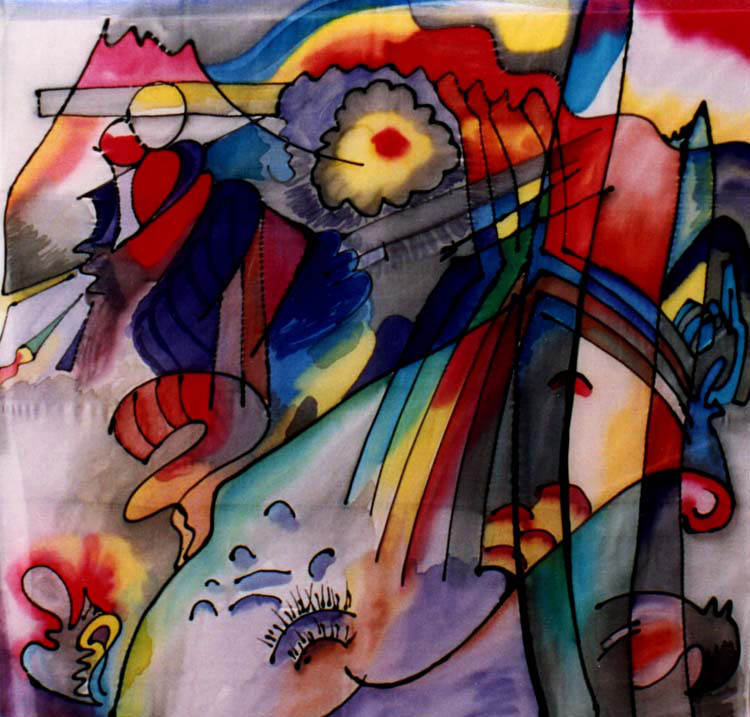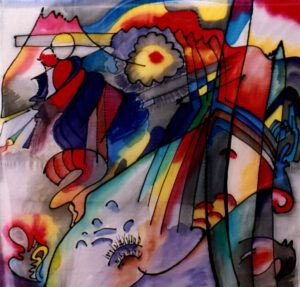“Vasily Kandinsky: Around the Circle” is an exhibit of the work of this influential Russian painter running at the Guggenheim Museum in NYC through September 2022.
Born December 16, 1866 Wassily Kandinsky was a hugely influential painter and art theorist credited with painting one of the first purely abstract works of art First Abstract Water Colour in 1910 . What’s less well known are his spiritual interests which influenced by Theosophy and most overtly expressed in the second chapter of his first book on art theory “Concerning The Spiritual In Art,” the chapter entitled “Spiritual Revolution.”
Further, as author Gary Lachman points out in his article “Kandinsky’s Thought Forms and the Occult Roots of Modern Art”:
“As Sixten Ringbom made clear in his seminal study, “The Sounding Cosmos,” Kandinsky was deeply interested in a number of occult, mystical, and paranormal pursuits and, at times, was a practitioner of various spiritual disciplines, specifically some forms of meditation and visualization. His interest was wide and his reading eclectic; one form of paranormal phenomena that particularly intrigued him was ‘thought photography,’ the idea that thoughts could be captured on sensitive plates.” This phenomena not being unrelated to how Kandinsky eventually came to the view the process of painting for the true artist.
Lachman also points out: “Kandinsky’s occult library was considerable, but certain books in particular fuelled his speculation. Three key works were Man, Visible and Invisible (1902) by C. W. Leadbeater, Thought-Forms (1905) by Annie Besant and Leadbeater, and Rudolf Steiner’s Theosophy (1904).”
The museum’s posting on the exhibit states:
“Vasily Kandinsky is recognized as a major artistic innovator and painting theorist. In the opening decades of the twentieth century, he was among those who advanced nonrepresentational modes of art-making to lasting effect. The artist’s stylistic evolution in this regard was intimately tied to his sense of place and the communities with which he engaged. Kandinsky gained insight from meaningful intersections with artists, musicians, poets, and other cultural producers, especially those who shared his transnational vision and experimental bent. Uprooted time and again, he adapted with his every relocation across Germany, back to Russia, and eventually to France—all against the backdrop of the sociopolitical upheavals occurring around him.
“In this exhibition, Kandinsky’s work unfolds in reverse chronological order, starting with his late-life paintings and proceeding upward along the Guggenheim’s spiral ramp. His was not a fixed path from representation to abstraction, but rather a circular passage traversing persistent themes centered around the pursuit of one dominant ideal: the impulse for spiritual expression. This, what Kandinsky called the artist’s “inner necessity,” remained the guiding principle through the periodic redefinitions of his life and work.
“The presentation begins with Kandinsky’s final chapter set in France. The natural sciences and the Surrealist movement, as well as an abiding interest in Russian and Siberian cultural practices and folklore, informed his organic imagery and prompted recurrent themes of renewal and metamorphosis. Paintings from his decade of teaching at the Bauhaus, a progressive German school, manifest Kandinsky’s conviction that art could transform self and society and exemplify the revitalization of his “non-concrete” style following direct contact with the avant-garde in Russia. The final section of the show examines Kandinsky’s earliest paintings, made while he was living around Munich. There he participated in heightened vanguard activity across multiple disciplines, fluidly moving between painting, poetry, and stage composition, for example. In time the artist interrogated the expressive possibilities of color, line, and form.
“At every turn Kandinsky responded to his environment and developed new ways to probe the spiritual in art. These paintings, watercolors, and woodcuts drawn from the museum’s extensive Kandinsky collection illuminate the journey of an artist who would not leave behind the precedents of representation or of his own work altogether, even as he explored the transcendent potential of abstract forms.
“Vasily Kandinsky: Around the Circle is organized by Megan Fontanella, Curator, Modern Art and Provenance.”
Interestingly, the Guggenheim’s founder and namesake Solomon Guggenheim began collecting Kandinsky during the artist’s lifetime at the urging of Hilla Rebay, the co-founder and first director of the museum. Rebay was also responsible for bringing EGC Bishop Harry Smith NYC and having him receive a Solomon Guggenheim Grant.
https://www.guggenheim.org/exhibition/vasily-kandinsky-around-the-circle.


